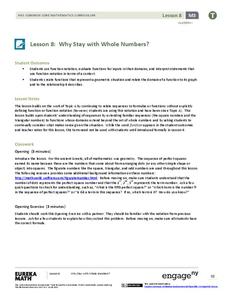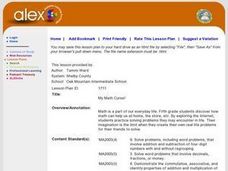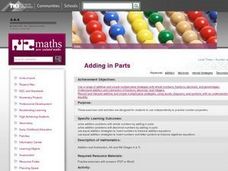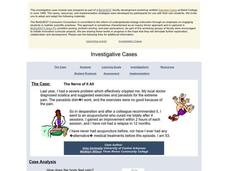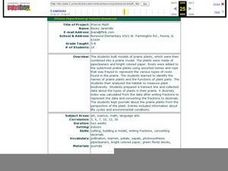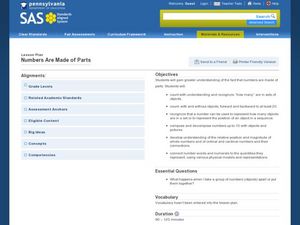EngageNY
Why Stay with Whole Numbers?
Domain can be a tricky topic, especially when you relate it to context, but here is a instructional activity that provides concrete examples of discrete situations and those that are continuous. It also addresses where the input values...
Curated OER
My Math Curse!
Math novices examine how math can help them in real-world situations. They listen to the book The Math Curse by Jon Scieszka, solve various word problems from the book, explore various math websites, write original math word problems,...
EngageNY
Construct an Equilateral Triangle (part 1)
Drawing circles isn't the only thing compasses are good for. In this first installment of a 36-part series, high schoolers learn how to draw equilateral triangles by investigating real-world situations, such as finding the location of a...
Illustrative Mathematics
Cooking with the Whole Cup
Whoops! Travis accidentally put too much butter into the recipe. Your bakers must find out how to alter the recipe to accommodate different changes by using unit rates and ratios . The activity has multiple parts and calculations with...
Pennsylvania Department of Education
Fractional Parts Using an Area Model
Learners explore multiplying fractions and their relationship to parts of a whole. They draw and shade fractional parts to show parts of a whole and fractional parts of a fraction. Pupils also use an Internet site for interactive...
Curated OER
Exploring Parts and Wholes
Students make accurate and interesting statments about how parts of something are related to the whole thing. To begin the lesson, students have to identify as many parts of a toy dumptruck as they can and find the part they find most...
EngageNY
Percent of a Quantity
Visualize methods of finding percents. Classmates find a percent of a quantity using two methods including a visual model in the 26th lesson in a series of 29. By the end of the lesson, scholars find percents given a part and the whole...
Illustrative Mathematics
Money in the Piggy Bank
It's time to crack open that piggy bank and see what's inside. First, count up the pennies, nickels, dimes, and quarters, identifying what fraction of them are dimes. Then calculate the total value of the coins, writing another fraction...
Institute for Teaching through Technology and Innovative Practices
The Right Number of Elephants
How can you tell if a number of items is reasonable? Combine math and language arts with a fun lesson based on Jeff Shepard's The Right Number of Elephants. After reading the book, kids discuss amounts of other items and create...
Curated OER
Finding Fractional Parts Of A Set
For this finding fractional parts of a set worksheet, learners, working with a partner, problem solve seven word problems and equations involving fractional parts.
Curated OER
Fractions- Fraction Strips
In this fraction worksheet, students read about fractions as parts of a whole fraction strip at the top of the page. They write the fractions for each shaded part and each unshaded part of 7 fraction pictures. They shade the indicated...
Curated OER
Adding in Parts
Third graders are able to split whole numbers into parts. They make numbers up to a tidy number. Students add and subtract tenths to make a decimals number into a whole number. They are able to add whole numbers up to three digits.
Curated OER
Finding Total Given Part and Percentage
Students observe models of fractional parts. After writing the definitions of percent, part and whole, students use the calculators and computers to solve problems. Individually, they complete assigned problems where the convert the...
Illustrative Mathematics
Banana Pudding
Making banana pudding despite misplacing your one-cup measuring cup is easy as long as you can find your quarter-cup measuring cup! This real-life activity provides a good opportunity for learners to interpret division of a whole...
Illustrative Mathematics
Dividing by One-Half
Understanding when to divide by two or one-half can be confusing. Here is an activity that gives four different scenarios. It is up to your number crunchers to decide if they divide by two or one-half. The easiest way to approach the...
Curated OER
Fractions: Mud Pie Math
Second graders identify and name fractional parts through the use of mud pie manipulatives. In this fractional manipulatives lesson, 2nd graders identify and label halves, thirds, fourths, sixths, eighths, and tenths and order them...
Curated OER
The Math Of African Music
Students practice rhythms and fractions on African drums in this Music lesson plan mixing Math skills and music notation. The lesson plan also includes ideas for assessment and state and national benchmarks met.
Curated OER
Prairie Math
Students work together to build models of prairie plants. Using the model, they estimate the height and then measure them using metric and standard units. They write a fraction to represent their part of the whole set and compare and...
Pennsylvania Department of Education
Numbers Are Made of Parts
Children play with barnyard animal cards to practice composing and decomposing numbers. With their "secret number" of animal cards in a cup, they shake and spill them onto a barn story board, counting how many animals fall in the barn...
Illustrative Mathematics
Shape Hunt Part 1
The hunt is on! Send young mathematicians on a search for shapes in the first lesson of this two-part series. Each time a child finds a hidden shape, he draws it on his paper, and continues searching for the rest. Perform this activity...
EngageNY
Problem Solving When the Percent Changes
Use more than one whole to solve percent problems. The ninth installment in a 20-part series has pupils work percent problems in which they must determine two wholes. Individuals use double number lines to represent and solve the...
EngageNY
Equivalent Ratios II
What is the connection between equivalent ratios? Class members first find the multiplication factor used to create equivalent ratios. Next, they take that information to determine whether ratios are equivalent. The second lesson on...
Curated OER
Fractions: Parts of a Set
Students identify, model, and label simple fractions. They describe and define them as equal parts of a whole, a region and a set. Students use words to describe fractions. They use manipulatives to explore the many different fractions.
Curated OER
Dividing Whole Numbers by the Power of Ten
Knowing how to properly place the decimal point when dividing by powers of ten is an important skill. Here is a lesson which should give your learners a good understanding of this technique. One nice thing about the lesson is the many...
